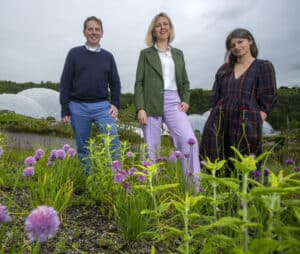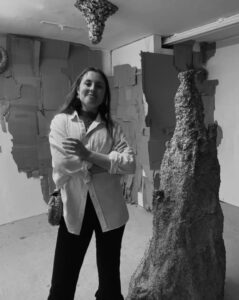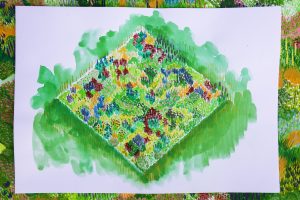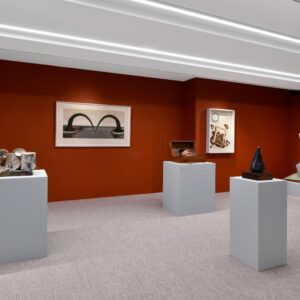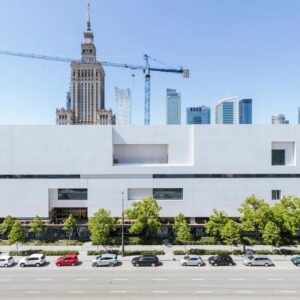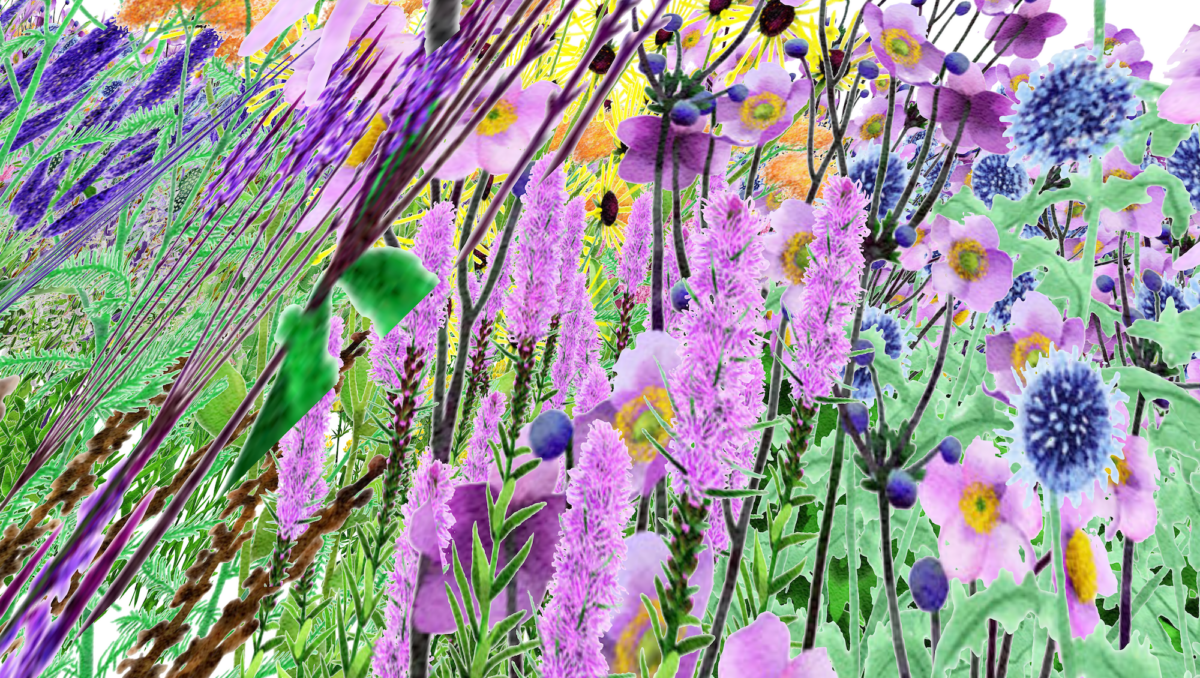
Pollinator Pathmaker in Human Vision 2023 Credit: Alexandra Daisy Ginsberg Ltd © Alexandra Daisy Ginsberg Ltd. Courtesy of the artist and the Design Museum
This summer, the Design Museum will stage a landmark exhibition on more than-human design. More than Human marks the first curatorial collaboration between the Design Museum and its national design research programme, Future Observatory, in a major exhibition. From an enormous nature calendar to spaces designed for multispecies encounters, this exhibition aims to set a new direction for design based on humanity’s collaboration with the living world.
More than Human refers to a growing design movement that questions the human-centric lens that has defined Western design practice and embraces the idea that the flourishing of all species is interconnected. More-thanhuman design calls for focused attention on the needs of environments and the species they host. Designers, architects and artists are increasingly directing their work towards the needs of non-human species. The approaches emerging range from the sharing of ancient knowledge to the design of new habitats and, ultimately, the shifting of perspectives.
“It’s important for museums and cultural institutions to respond to the complex issues facing our planet and society at present. It’s also important to shift perspectives from a human-centric view of the world to one closer to nature which will make this a landmark exhibition in every sense. More than Human will showcase some of the ground-breaking work that Future Observatory has done at the museum and beyond over the last three years, a blend of extensive sustainable research, critical thinking and advocacy which is central to our cultural programming.”
Tim Marlow, Director and CEO of the Design Museum
Highlights include major new commissions by four designers who were supported with Future Observatory research fellowships. Alexandra Daisy Ginsberg is producing a vast new tapestry exploring the perspectives of pollinators, while an 8m-long mural by MOTH (More Than Human Life Project) depicts the growing movement to award legal rights to waterways around the world. The other research commissions are by the Brazilian architect Paulo Tavares and the Chinese spatial and visual designer Feifei Zhou. Meanwhile, the designer Julia Lohmann is creating a large-scale seaweed installation specifically for the exhibition, a series of organic forms that will appear to grow from the floor of the gallery. The exhibition and new commissions are funded by UKRI’s Arts and Humanities Research Council (AHRC).
There are more than 50 artists, architects and designers in the exhibition, including Ant Farm, Marcus Coates, Dunne & Raby, Forensic Architecture, Formafantasma, Andrés Jaque, Julia Lohmann, Kate Orff/Scape, Solange Pessoa, Reef Design Lab, Diana Scherer and Xu Tiantian to name a few, several of whom are presenting new work.
By bringing together over 140 works spanning contemporary and traditional practices, fine art, product design, architecture and interactive installations, the exhibition will explore how humans can relearn to design with and for the natural world in the face of climate emergency.
Being Landscape
The exhibition is structured into three sections. Visitors will first encounter ‘Being Landscape’, showcasing art and design that conveys the idea that humans are very much part of the natural world, not separate to it. This section includes a major new commission, an 8m-long mural by MOTH (More Than Human Life Project), including lawyer César RodriguezGaravito, author Robert Macfarlane and illustrator Elena Landinez. The expansive mural depicts a sprawling network of interconnected rivers decorated with a myriad of illustrations of animals, plant life and text, addressing the growing movement to award legal rights to waterways around the world.
Also featured here are three paintings by Brazilian artist Solange Pessoa, whose work dissolves the boundaries between human, animal and vegetal and evokes the animistic beliefs of Indigenous peoples. On loan from Pinacoteca do Estado de São Paulo will be a painting by artist and former rubber tapper Hélio Melo, whose works record his personal relationship with the forest and the longstanding threat to the Brazilian Amazon from global agribusiness.
Our relationship with trees is also examined through a European lens with photographic works by Federico Borella and Michela Balboni, who document the ancestral ritual in Southern Italy of the ‘Rumiti’, tree-men covered in ivy who act as living symbols of a deep connection with nature and its preservation. Renowned British artist Johnathan Baldock will present a series of bronze-cast cornhusk masks inspired by pagan corn dollies. Baldock’s interest in craft and working-class histories stems from his family’s agricultural background in Kent, England.
This idea of weaving one’s relationship with the land into crafted objects can also be observed with the Ye’kuana, an Indigenous community in the Venezuelan Amazon who are renowned for their basketry, several examples of which will be on show in the exhibition.
Marcus Coates’ Nature Calendar functions as a reminder of the parallel lives and activities of the species we live amongst. The days of Coates’s calendar each reference a natural event, recalling a time when humans would once recognise the passage of time through minute seasonal shifts. Visitors to the exhibition will be able to see what natural phenomenon is taking place on the exact day they visit the museum.
Making with the World
The second section, ‘Making with the World’, provides both practical and speculative design solutions that are made for the benefit of plants, animals and environments.
On show will be historical fishing traps from communities in the UK, Myanmar, Indonesia, Nicobar Islands and the Waswahili (Swahili) people demonstrate how traditional, localised techniques are far less impactful on marine ecosystems compared to modern fishing.
This section also features contemporary design innovations that help restore damaged and dying marine ecosystems such as coral reefs. Reef Design Lab’s Living Seawalls, a man-made habitat for marine life, will be exhibited alongside the lab’s Modular Artificial Reef Structure II, which is dropped to the ocean floor to help regenerate and repopulate natural reef structures.
Travelling from the ocean to land, the exhibition recreates a version of the award-winning Alusta Pavilion designed by architects Elina Koivisto and Maiju Suomi, first constructed in Helsinki in 2022. The pavilion’s main structure will be built using unfired, mass-produced insulation bricks to create a form that provides shelter for humans and insects alike. Designed as a space for multispecies encounters, the pavilion demonstrates how architecture can encourage biodiversity in urban environments.
German designer Johanna Seelemann incorporates her research into historic irrigation practices into a contemporary design approach with her works entitled Oase. On show will be several terracotta vessels that are designed improve the conditions of tress in urban spaces that were inspired by the forms of car fuel tanks.
Shifting Perspective
The final section, ‘Shifting Perspective’, asks us to consider how plants and animals perceive the world and identify their place within it.
This section includes nests from various species including wasps, ants and birds, intricate structures that provide a glimpse into the needs and decision-making of these creatures. It also features a seminal early work of more-than-human design by the art collective Ant Farm. Dolphin Embassy, from 1974, was an extensive research project that sought to build a marine centre for communication between humans and dolphins.
Japanese artist Shimabuku’s long-term fascination with the behaviour of octopuses is on display, conveyed through the small glass balls he created for Sculpture for Octopuses: Exploring for Their Favorite Colors, which will be exhibited alongside a slideshow documenting the octopuses’ reactions.
Future Observatory fellow Alexandra Daisy Ginsberg will present a new iteration of her artwork Pollinator Pathmaker, a vibrant tapestry depicting a potential living artwork. Reminding us of the need for empathy for other species, the tapestry shows the unrealised garden from the perspective of a pollinating insect. Ginsberg is one of four Fellows who received funding to conduct research and produce a new work for the exhibition. Her tapestry incorporates research from her work with the Eden Project to create an algorithm that could design planting schemes for gardens that specifically cater to the needs of pollinator species.
The exhibition concludes with a monumental seaweed installation by Julia Lohmann, a German-born designer and researcher who investigates and critiques the ethical and material value systems underpinning our relationship with flora and fauna. Lohmann is creating a compelling new installation that visitors will be able to walk through, surrounding them with the smells and materiality of coastal zones. For the last three years Future Observatory, the Design Museum’s national research programme for the green transition, in partnership with the Arts and Humanities Research Council, has funded more than 100 research projects pursuing more sustainable design. Future Observatory has howcased this research through several free displays on the top floor ofthe museum,acting as an example for how museums and culturalinstitutions can integrate meaningful sustainable initiatives into a cultural programme.
More than Human is a major milestone in Future Observatory’s mission to harness the cultural power of the Design Museum to engagebroad audiences in new thinking that can help drive the green transition.
More than Human is co-curated by Future Observatory director Justin McGuirk and the Design Museum’s senior curator Rebecca Lewin and will be accompanied by a lavishly illustrated catalogue.
Justin McGuirk, Director of Future Observatory says,
“This is not just another exhibition about ‘sustainable design’, this is a radical rethink of design’s role in the world. While much of the work in the exhibition is nascent or exploratory, it represents a fundamental shift in worldview toward humans using design not just for their own benefit but for the flourishing of the living systems we depend upon. More than Human is what design needs to become in the 21 st century.”
More than Human, 11th July–6th October 2025
the Design Museum
